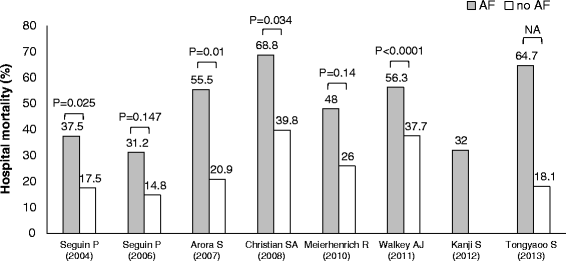Epidemiology, prevention, and treatment of new-onset atrial fibrillation in critically ill: a systematic review
- PMID: 25914828
- PMCID: PMC4410002
- DOI: 10.1186/s40560-015-0085-4
Epidemiology, prevention, and treatment of new-onset atrial fibrillation in critically ill: a systematic review
Abstract
Background: Atrial fibrillation (AF) is a common arrhythmia in the ICU. The aim of this review is to summarize relevant information on new-onset AF in non-cardiac critical illness with respect to epidemiology, prevention, and treatment.
Methods: We conducted a PubMed search in June 2014 and included studies describing the epidemiology, prevention, and treatment of new-onset AF and atrial flutter during ICU stay in non-cardiac adult patients. Selected studies were divided into the three categories according to the extracted information. The methodological quality of selected studies was described according to the Grading of Recommendations Assessment, Development and Evaluation system.
Results: We identified 1,132 citations, and after full-text-level selection, we included 10 studies on etiology/outcome and five studies on treatment. There was no study related to prevention. Overall quality of evidence was mostly low or very low due to their observational study designs, small sample sizes, flawed diagnosis of new-onset AF, and the absence of mortality evaluation. The incidence of new-onset AF varied from 4.5% to 15.0%, excluding exceptional cases (e.g., septic shock). Severity scores of patients with new-onset AF were higher than those without new-onset AF in eight studies, in four of which the difference was statistically significant. Five studies reported risk factors for new-onset AF, all of which used multivariate analyses to extract risk factors. Multiple risk factors are reported, e.g., advanced age, the white race, severity scores, organ failures, and sepsis. Hospital mortality in new-onset AF patients was higher than that of patients without AF in all studies, four of which found statistical significance. Among the five studies on treatment, only one study was randomized controlled, and various interventions were studied.
Conclusions: New-onset AF occurred in 5%-15% of the non-cardiac critically ill patients. Patients with new-onset AF had poor outcomes compared with those without AF. Despite the high incidence of new-onset AF in the general ICU population, currently available information for AF, especially for management (prevention, treatment, and anticoagulation), is quite limited. Further research is needed to improve our understanding of new-onset AF in critically ill patients.
Keywords: Atrial fibrillation; Critical care; Outcome; Prevention; Systematic review; Treatment.
Figures
Similar articles
-
Prevalence, Outcomes, and Risk Factors of New-Onset Atrial Fibrillation in Critically Ill Patients.Int Heart J. 2020 May 30;61(3):476-485. doi: 10.1536/ihj.19-511. Epub 2020 Apr 29. Int Heart J. 2020. PMID: 32350206
-
[Risk factors of atrial fibrillation in critical ill patients].Zhonghua Wei Zhong Bing Ji Jiu Yi Xue. 2018 Apr;30(4):337-341. doi: 10.3760/cma.j.issn.2095-4352.2018.04.010. Zhonghua Wei Zhong Bing Ji Jiu Yi Xue. 2018. PMID: 29663995 Chinese.
-
New-onset atrial fibrillation is associated with increased mortality in critically ill patients: a systematic review and meta-analysis.Acta Cardiol. 2019 Apr;74(2):162-169. doi: 10.1080/00015385.2018.1477035. Epub 2018 Jul 5. Acta Cardiol. 2019. PMID: 29975173
-
Atrial Fibrillation Is an Independent Predictor of Mortality in Critically Ill Patients.Crit Care Med. 2015 Oct;43(10):2104-11. doi: 10.1097/CCM.0000000000001166. Crit Care Med. 2015. PMID: 26154932 Free PMC article.
-
Risk factors for new-onset atrial fibrillation on the general adult ICU: protocol for a systematic review.BMJ Open. 2018 Sep 4;8(9):e024640. doi: 10.1136/bmjopen-2018-024640. BMJ Open. 2018. PMID: 30181189 Free PMC article.
Cited by
-
Cardiovascular Complications of Obstructive Sleep Apnea in the Intensive Care Unit and Beyond.Medicina (Kaunas). 2022 Oct 3;58(10):1390. doi: 10.3390/medicina58101390. Medicina (Kaunas). 2022. PMID: 36295551 Free PMC article. Review.
-
New-Onset Atrial Fibrillation and Early Mortality Rate in COVID-19 Patients: Association with IL-6 Serum Levels and Respiratory Distress.Medicina (Kaunas). 2022 Apr 11;58(4):530. doi: 10.3390/medicina58040530. Medicina (Kaunas). 2022. PMID: 35454369 Free PMC article.
-
Atrial fibrillation in critically ill patients who received prolonged mechanical ventilation: a nationwide inpatient report.Korean J Intern Med. 2021 Nov;36(6):1389-1401. doi: 10.3904/kjim.2020.142. Epub 2021 Jul 12. Korean J Intern Med. 2021. PMID: 34247459 Free PMC article.
-
Clinical prediction scores and early anticoagulation therapy for new-onset atrial fibrillation in critical illness: a post-hoc analysis.BMC Cardiovasc Disord. 2021 Sep 8;21(1):423. doi: 10.1186/s12872-021-02235-8. BMC Cardiovasc Disord. 2021. PMID: 34496749 Free PMC article.
-
Managing new-onset atrial fibrillation in critically ill patients: a systematic narrative review.BMJ Open. 2020 Mar 24;10(3):e034774. doi: 10.1136/bmjopen-2019-034774. BMJ Open. 2020. PMID: 32209631 Free PMC article.
References
LinkOut - more resources
Full Text Sources
Other Literature Sources
Medical



